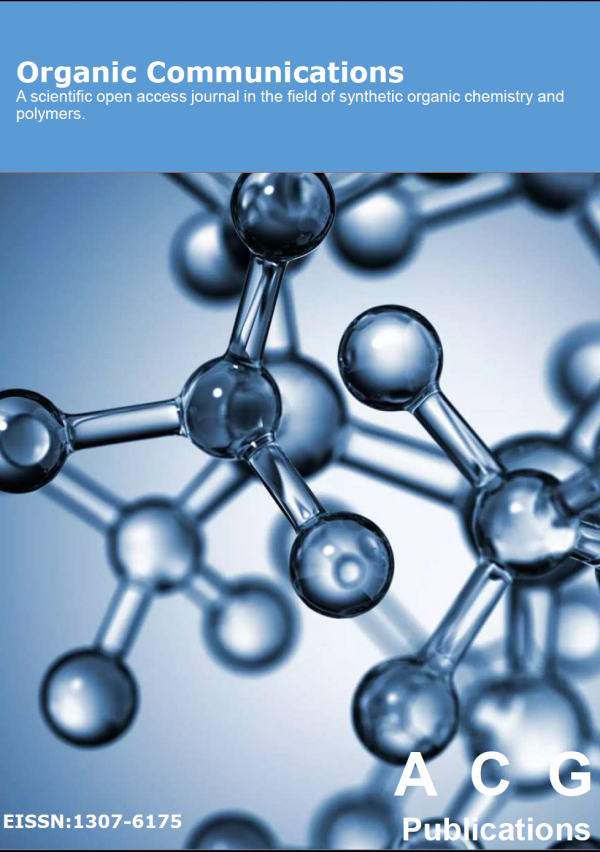Organic Communications
Year: 2020 Volume: 13 Issue:1 January-March
1) A walk on the road leading to science
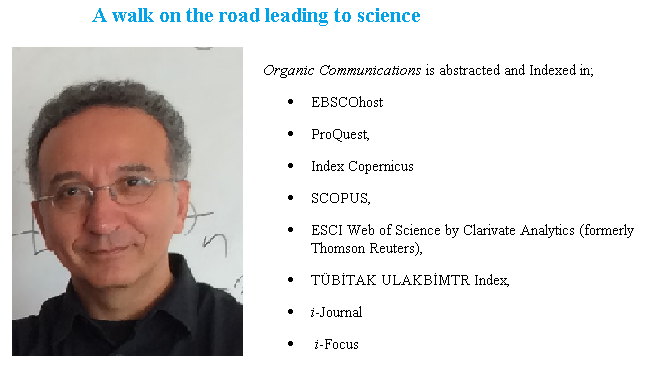
Organic Communications started to be published by ACG Publications in 2008. And now it is abstracted indexed in: Chemical Abstracts Service, EBSCOhost, DOAJ, ProQuest, Google Scholar, Index Copernicus, CrossRef, SCOPUS, ESCI Web of Science by Clarivate Analytics (formerly Thomson Reuters), TÜBİTAK ULAKBİMTR Dizin; i-Journals; i-Focus.
DOI http://doi.org/10.25135/acg.oc75.20.03.1558 Keywords Organic Communications Scopus ESCI Chemical Abstracts DETAILS PDF OF ARTICLE © 2020 ACG Publications. All rights reserved.2) Microwave-assisted synthesis of some new bis-1,3-benzoxazines and their antimicrobial activity
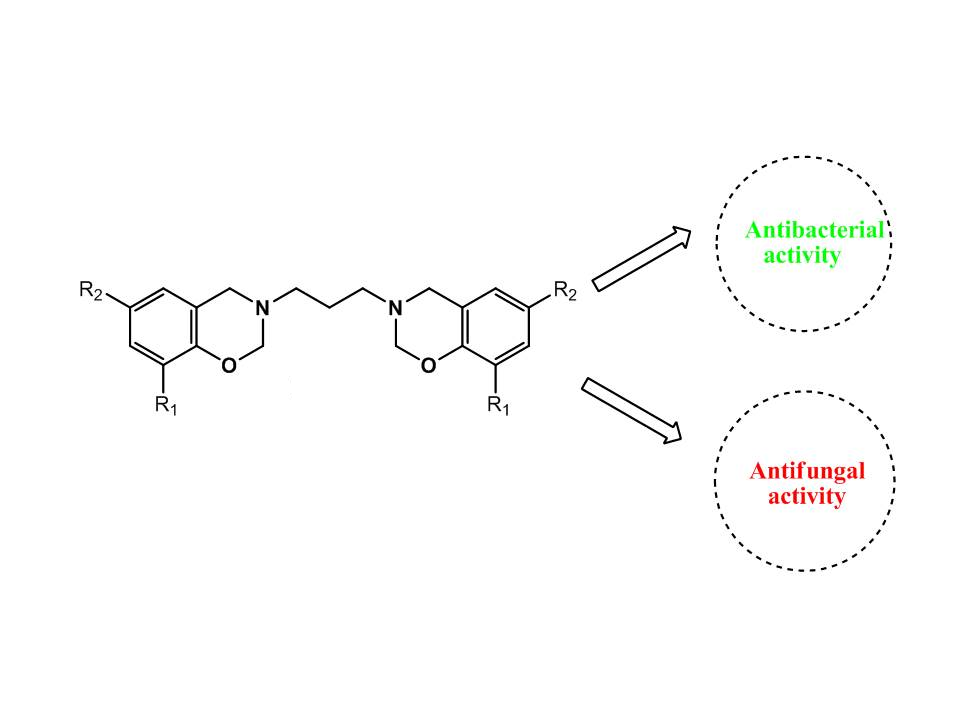
A series of bis-1, 3-benzoxazines (3a-f) were synthesized from reduced product of propane-1, 3-diamine Schiff bases in the presence of formalin under conventional heating and microwave irradiation. The structures of newly synthesized diamines and bis-1, 3-benzoxazines were established on the basis of spectroscopic data. Further, all the synthesized compounds were screened for antimicrobial activity. Some of the compounds showed very good activity compared to standard drugs against all pathogenic bacteria and fungi.
DOI http://doi.org/10.25135/acg.oc.71.02.01.1521 Keywords Bis-Schiff bases bis-1, 3-propane diamines microwave irradiation antimicrobial activity DETAILS PDF OF ARTICLE © 2020 ACG Publications. All rights reserved.3) Boron/Nitrogen Co-doped carbon quantum dots as a high sensitive and selective fluorescent sensor for PO43- detection
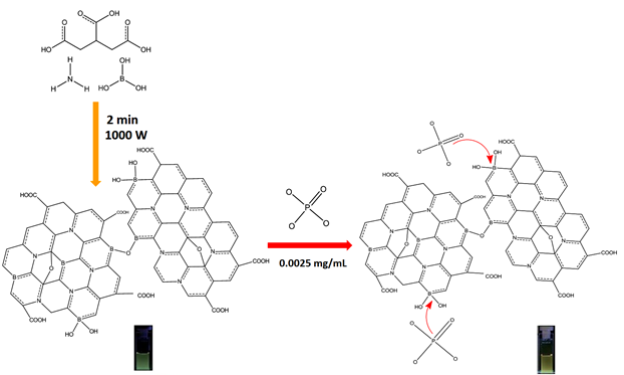
Boron/Nitrogen doped carbon quantum dots (BNCQD) was synthesized and its physiochemical and optical properties were investigated by FT-IR, XRD, XPS, TEM and spectroscopic methods. The freshly prepared BNCQD shows a strong green fluorescence at 400 nm excitation, and PO43- anion can readily turn-on the fluorescence of BNCQD through forming stable complex. Then, we designed a turn-on fluorescence sensor for phosphate ion detection which indicate a high selectivity towards PO43- ions in comparison with the other anions with a limit of detection of 0.1 µM. It was approved that BNCQD is highly sensitive and selective to detect PO43- anion in wastewater.
DOI http://doi.org/10.25135/acg.oc.76.20.01.1530 Keywords B/N-carbon dots phosphate sensor DETAILS PDF OF ARTICLE © 2020 ACG Publications. All rights reserved.4) Synthesis and characterization of some novel fluoro and methoxy substituted chalcone derivatives via nucleophilic aromatic substitution
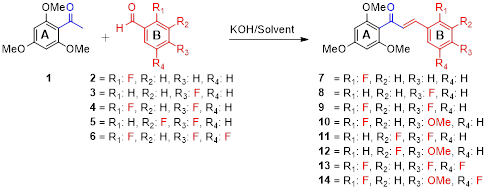
In this study, 2′,4′,6′-Trimethoxyacetophenone was reacted with various fluorine-substituted benzaldehydes in the presence of an aqueous solution of 50%-potassium hydroxide, and new chalcone derivatives in the structure of 1,3-diaryl-2-propenone comprising both fluorine and methoxy groups in the aromatic B ring were obtained in high yields under mild conditions. In base-catalyzed Claisen-Schmidt condensations, MeOH is usually used as solvent. In the condensation reactions performed with mono-fluorine-substituted benzaldehydes in MeOH, the corresponding fluorine-substituted chalcone derivatives in the B ring were synthesized in high yield. On the other hand, when di- and tri-fluorine-substituted benzaldehydes were used, it was determined that a nucleophilic aromatic substitution (SNAr) occurred in the reaction condition and the condensation yield decreased. Consequently, fluorine-methoxy substituted chalcone derivatives were isolated by substitution of fluorine and methoxy group in para position in the aromatic B ring. On the other hand, it was found that when THF was used as the reaction solvent, chalcone derivatives carrying only fluorine atoms could be obtained with excellent chemical selectivity without any competitive aromatic nucleophilic substitution (SNAr) in the condition. Particularly in the synthesis studies of such fluorine-substituted chalcones, it was determined that the Claisen–Schmidt condensation ratio is dependent on the effect of the solvent in addition to steric and electronic factors.
DOI http://doi.org/10.25135/acg.oc.73.20.02.1555 Keywords Fluorine methoxy chalcone synthesis DETAILS PDF OF ARTICLE © 2020 ACG Publications. All rights reserved.5) ZrCl4-catalyzed one-pot multi-component synthesis of hexahydropyrano pyrimidinone derivatives
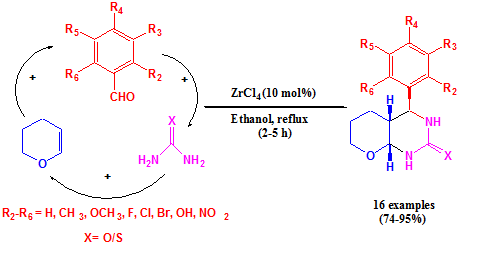
In this study, zirconium tetrachloride is used as a highly efficient catalyst for the one-pot three component reaction of 3,4-dihydro(2H)-pyran, urea and benzaldehyde in ethanol, producing corresponding hexahydropyrano pyrimidinone derivatives in good yields, with excellent diastereoselectivity. This method has various benefits such as easy availability of starting materials, lower cost, higher yield and shorter reaction time.
DOI http://doi.org/10.25135/acg.oc.72.20.02.1551 Keywords Multi-component reactions aldehydes urea/thiourea 3,4-dihydro(2H)-pyran atalysis DETAILS PDF OF ARTICLE © 2020 ACG Publications. All rights reserved.
